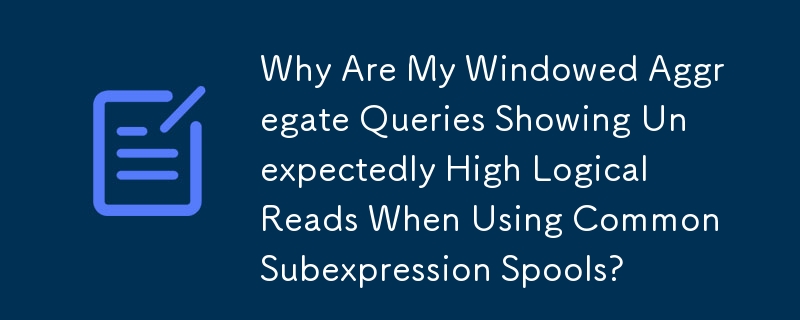 Database
Database
 Mysql Tutorial
Mysql Tutorial
 Why Are My Windowed Aggregate Queries Showing Unexpectedly High Logical Reads When Using Common Subexpression Spools?
Why Are My Windowed Aggregate Queries Showing Unexpectedly High Logical Reads When Using Common Subexpression Spools?
Why Are My Windowed Aggregate Queries Showing Unexpectedly High Logical Reads When Using Common Subexpression Spools?

Why High Logical Reads for Windowed Aggregate Functions with Common Subexpression Spools?
When using common subexpression spools in execution plans, notably for windowed aggregate functions, surprisingly high logical reads for large tables have been observed. This behavior raises concerns about the efficiency of such spools.
Root Cause: Unique Counting of Logical Reads for Worktables
Unlike traditional spool tables, logical reads for worktables, which are internal structures used for aggregation, are counted differently. Instead of measuring hashed pages, worktable logical reads are incremented for each row read. This unique counting method results in seemingly high counts, despite worktables being highly efficient.
Understanding the Formula
In your specific case, the formula you discovered, "Worktable logical reads = 1 NumberOfRows 2 NumberOfGroups 4," holds true due to the specific behavior of these spools:
- 1 : Initial overhead and final dummy row
- NumberOfRows * 2: Full read of both secondary spools
- NumberOfGroups * 4: Primary spool emits (NumberOfGroups 1) rows
Additional Insights
- The primary spool emits an additional row to signal the end of the final group.
- The formula accounts for this extra row in the final component, making it NumberOfGroups 1.
Troubleshooting Tips
While tracing page reads is not an option for worktables, understanding these unique counting mechanisms can help explain the observed high logical reads.
Reference
For further clarification, refer to:
- Query Tuning and Optimization Book, Chapter 3
- Paul White's blog post on common subexpression spools
The above is the detailed content of Why Are My Windowed Aggregate Queries Showing Unexpectedly High Logical Reads When Using Common Subexpression Spools?. For more information, please follow other related articles on the PHP Chinese website!

Hot AI Tools

Undresser.AI Undress
AI-powered app for creating realistic nude photos

AI Clothes Remover
Online AI tool for removing clothes from photos.

Undress AI Tool
Undress images for free

Clothoff.io
AI clothes remover

AI Hentai Generator
Generate AI Hentai for free.

Hot Article

Hot Tools

Notepad++7.3.1
Easy-to-use and free code editor

SublimeText3 Chinese version
Chinese version, very easy to use

Zend Studio 13.0.1
Powerful PHP integrated development environment

Dreamweaver CS6
Visual web development tools

SublimeText3 Mac version
God-level code editing software (SublimeText3)

Hot Topics
 1378
1378
 52
52
 How do you alter a table in MySQL using the ALTER TABLE statement?
Mar 19, 2025 pm 03:51 PM
How do you alter a table in MySQL using the ALTER TABLE statement?
Mar 19, 2025 pm 03:51 PM
The article discusses using MySQL's ALTER TABLE statement to modify tables, including adding/dropping columns, renaming tables/columns, and changing column data types.
 Explain InnoDB Full-Text Search capabilities.
Apr 02, 2025 pm 06:09 PM
Explain InnoDB Full-Text Search capabilities.
Apr 02, 2025 pm 06:09 PM
InnoDB's full-text search capabilities are very powerful, which can significantly improve database query efficiency and ability to process large amounts of text data. 1) InnoDB implements full-text search through inverted indexing, supporting basic and advanced search queries. 2) Use MATCH and AGAINST keywords to search, support Boolean mode and phrase search. 3) Optimization methods include using word segmentation technology, periodic rebuilding of indexes and adjusting cache size to improve performance and accuracy.
 How do I configure SSL/TLS encryption for MySQL connections?
Mar 18, 2025 pm 12:01 PM
How do I configure SSL/TLS encryption for MySQL connections?
Mar 18, 2025 pm 12:01 PM
Article discusses configuring SSL/TLS encryption for MySQL, including certificate generation and verification. Main issue is using self-signed certificates' security implications.[Character count: 159]
 What are some popular MySQL GUI tools (e.g., MySQL Workbench, phpMyAdmin)?
Mar 21, 2025 pm 06:28 PM
What are some popular MySQL GUI tools (e.g., MySQL Workbench, phpMyAdmin)?
Mar 21, 2025 pm 06:28 PM
Article discusses popular MySQL GUI tools like MySQL Workbench and phpMyAdmin, comparing their features and suitability for beginners and advanced users.[159 characters]
 How do you handle large datasets in MySQL?
Mar 21, 2025 pm 12:15 PM
How do you handle large datasets in MySQL?
Mar 21, 2025 pm 12:15 PM
Article discusses strategies for handling large datasets in MySQL, including partitioning, sharding, indexing, and query optimization.
 Difference between clustered index and non-clustered index (secondary index) in InnoDB.
Apr 02, 2025 pm 06:25 PM
Difference between clustered index and non-clustered index (secondary index) in InnoDB.
Apr 02, 2025 pm 06:25 PM
The difference between clustered index and non-clustered index is: 1. Clustered index stores data rows in the index structure, which is suitable for querying by primary key and range. 2. The non-clustered index stores index key values and pointers to data rows, and is suitable for non-primary key column queries.
 How do you drop a table in MySQL using the DROP TABLE statement?
Mar 19, 2025 pm 03:52 PM
How do you drop a table in MySQL using the DROP TABLE statement?
Mar 19, 2025 pm 03:52 PM
The article discusses dropping tables in MySQL using the DROP TABLE statement, emphasizing precautions and risks. It highlights that the action is irreversible without backups, detailing recovery methods and potential production environment hazards.
 How do you create indexes on JSON columns?
Mar 21, 2025 pm 12:13 PM
How do you create indexes on JSON columns?
Mar 21, 2025 pm 12:13 PM
The article discusses creating indexes on JSON columns in various databases like PostgreSQL, MySQL, and MongoDB to enhance query performance. It explains the syntax and benefits of indexing specific JSON paths, and lists supported database systems.



